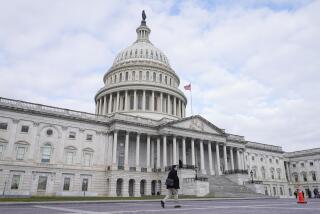House OKs Bill to Raise IRA, 401(k) Contribution Caps
WASHINGTON — The House on Wednesday overwhelmingly approved legislation that would sharply increase the limits on contributions to individual retirement accounts and other tax-favored pension programs.
The bill, approved 407-24, would gradually raise the limit on IRA contributions to $5,000 from $2,000 a year and increase the cap on annual contributions to 401(k) plans from $10,500 to $15,000. The effect of expanding the tax breaks provided by these retirement accounts would be to cut taxes by $52 billion over 10 years.
The bill is intended to offer new incentives for people to save for retirement and for employers to offer pensions to their workers at a time when the future solvency of Social Security is in question.
“This is a dramatic increase in what our constituents will be able to save for their retirement,” said Rep. Rob Portman (R-Ohio). “This bill is good for our future, good for our families.”
But critics said the bill, which now heads to the Senate, provides too little help to the lower- and middle-income people who need it the most. That echoes arguments Democrats have made that other tax cut bills being pushed by the GOP are too skewed to the wealthy. But that didn’t stop droves of Democrats from voting for the IRA bill, as such concerns took a back seat to the enormous political popularity of retirement savings incentives among aging baby boomers.
Although the White House supports the bill, the tax breaks were not included in President Bush’s $1.6-trillion, 10-year tax cut proposal. House approval of the measure is the latest example of the congressional penchant for adding to the menu of proposals in this year’s tax cut package--even as lawmakers on Tuesday reached agreement on a budget plan that would limit the tax cut to $1.35 trillion over 11 years.
In the wake of that agreement, White House and congressional leaders finished work Wednesday on the annual budget resolution by settling the remaining thorny question: how much to increase government’s “discretionary” spending, the portion of the budget controlled through annual appropriations. The budget resolution, which the House and Senate are expected to approve as early as today, would allow the spending to increase by about 5%--more than the 4% increase Bush sought but less than increases of 6% and more that Congress has approved in recent years. However, negotiators assume that an undetermined amount of additional money will be provided for the Pentagon and other contingencies.
Bush expressed satisfaction with the accord, saying it provides “the largest tax cut in a generation and reasonable levels of spending.”
Once it sets the target figures, Congress will spend the next weeks and months working out the details of the tax cuts and department-by-department spending.
The fate of the IRA bill will be part of that process.
The measure approved Wednesday is similar to one that nearly became law under President Clinton last year. That bill passed the House by a lopsided margin and enjoyed broad support in the Senate. But it stalled after it was linked to unrelated health provisions that Clinton opposed.
This year, a key question will be whether it gets folded into the $1.35-trillion tax cut bill the Senate plans to draft to carry out the budget resolution.
Senate Finance Committee Chairman Charles E. Grassley (R-Iowa) strongly supports the IRA bill but said Wednesday that he had not yet decided whether to include it in the larger tax cut bill or push it separately.
House Majority Leader Dick Armey (R-Texas) said passage of the IRA bill will remain one of his priorities but acknowledged it will face stiff competition from other popular tax breaks. “We have so much to do and so little room within the $1.35-trillion” ceiling for the tax cut, Armey said.
The budget resolution targets are nonbinding, however, so the IRA bill still could become law without being part of the larger tax cut package.
The IRA bill came before the House just as Bush was proposing a commission to study reform of Social Security, which faces huge financial pressure with the retirement of an estimated 76 million baby boomers within the next 15 years.
The House bill was designed to shore up two other pillars of retirement financing: private savings and employer-sponsored pensions. The bill’s proponents said its incentives are needed because studies have found that older baby boomers have less than 40% of the savings they need to maintain their standard of living in retirement. Employer pension plans need a boost, the measure’s backers said, because half of all private-sector workers have no pension program, according to the Department of Labor.
To encourage more individual savings, the bill would increase to $5,000 the annual limit on contributions to both traditional IRAs and so-called Roth IRAs. In traditional accounts, individuals get a tax deduction for their contributions but pay taxes when the money is withdrawn on retirement. In Roth IRAs, there is no tax deduction for the contribution but earnings can later be withdrawn tax-free.
The higher limits would be phased in by 2004--except for taxpayers age 50 and older, who would be permitted to contribute $5,000 to an IRA beginning in 2002. The limit on 401(k) contributions would rise to $15,000 in 2006.
In future years, the limits on both IRAs and 401(k) contributions would be indexed for inflation.
The bill would establish simplified pension rules to encourage small businesses to offer pension plans. It also contains provisions to improve benefits in multi-employer pension plans--provisions strongly backed by organized labor, which helped fuel Democratic support for the measure.
And it included provisions designed to accommodate greater mobility in today’s work force: It would make it easier to roll over pension fund assets to carry benefits from job to job.
Critics complained that the bill would do little to expand availability of pensions and increase savings among the low- to middle-income taxpayers who need help the most. They cited analyses showing that 70% of the tax subsidies provided by raising the IRA limit would go to 20% of the population. Increasing contribution limits will do little, critics argued, to help people who can’t even afford to save up to the current limits.
“If they can’t save $2,000 [in IRAs], let me tell you, they are not going to be able to save $5,000,” said Rep. Earl Pomeroy (D-N.D.).
Many Democrats cited a study by the Center on Budget and Policy Priorities, a liberal research group, that found only 4% of all taxpayers who were eligible for IRAs in 1995 contributed the full $2,000 and that 93% of eligible taxpayers made no contribution whatsoever.
“There’s no question that the benefits of this legislation would go mainly to the wealthy,” said Rep. Robert T. Matsui (D-Sacramento).
Before approving the bill, the House rejected a Democratic amendment to increase benefits to low- and middle-income workers and provide additional incentives for small businesses to offer pensions. That alternative was rejected, 223-207.
*
Times staff writer James Gerstenzang contributed to this story.
(BEGIN TEXT OF INFOBOX / INFOGRAPHIC)
How New Limits Would Work
Highlights of pension legislation passed by the House:
*
IRA Provisions
* Raises limits for traditional and Roth IRAs from $2,000 now to $3,000 in 2002, $4,000 in 2003 and $5,000 in 2004. Indexed for inflation thereafter.
* For individuals age 50 and older, raises limit to $5,000 beginning in 2002.
401(k)-type Provisions
* Boosts maximum annual tax-deferred contributions from $10,500 now to $11,000 in 2002, $12,000 in 2003, $13,000 in 2004, $14,000 in 2005 and $15,000 in 2006. Indexed for inflation thereafter. Limits on employer matching contribution also would increase.
* For individuals 50 and older, an additional $5,000 in contributions would be permitted beginning in 2002.
*
Other Provisions
* Vesting requirements for employer pension matching contributions would be reduced from five years to three years.
* Makes it easier for employees to roll over retirement assets when they change jobs and combine differing retirement plans.
* Simplifies regulations to encourage more businesses to offer pension plans and reduce costs for new plans for businesses with 100 or fewer employees.
* Increases from 15% to 20% the deduction limit for stock bonus and profit sharing plans.
* Increases employment and benefit limits for employer-provided pension plans.
Source: Associated Press
More to Read
Get the L.A. Times Politics newsletter
Deeply reported insights into legislation, politics and policy from Sacramento, Washington and beyond. In your inbox three times per week.
You may occasionally receive promotional content from the Los Angeles Times.











